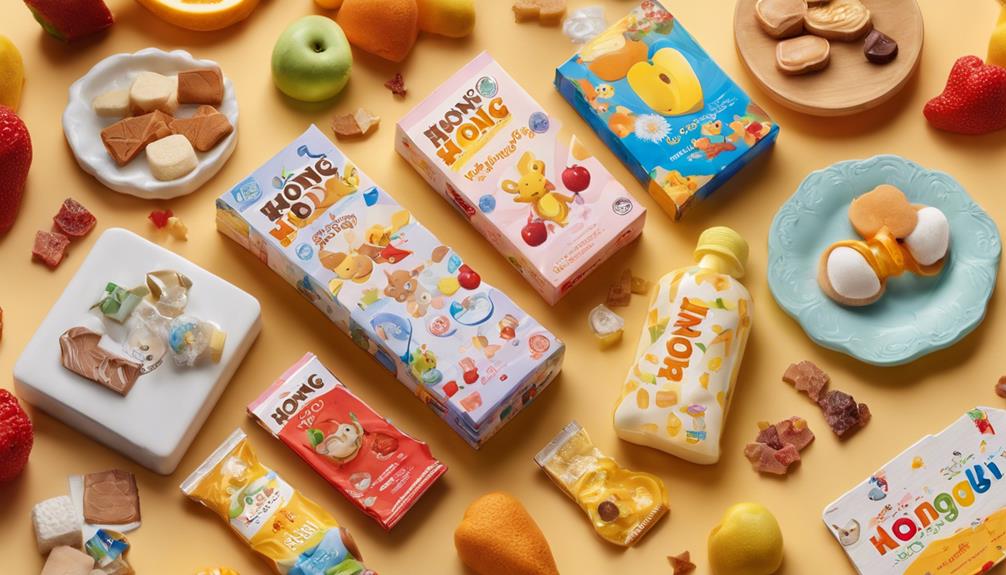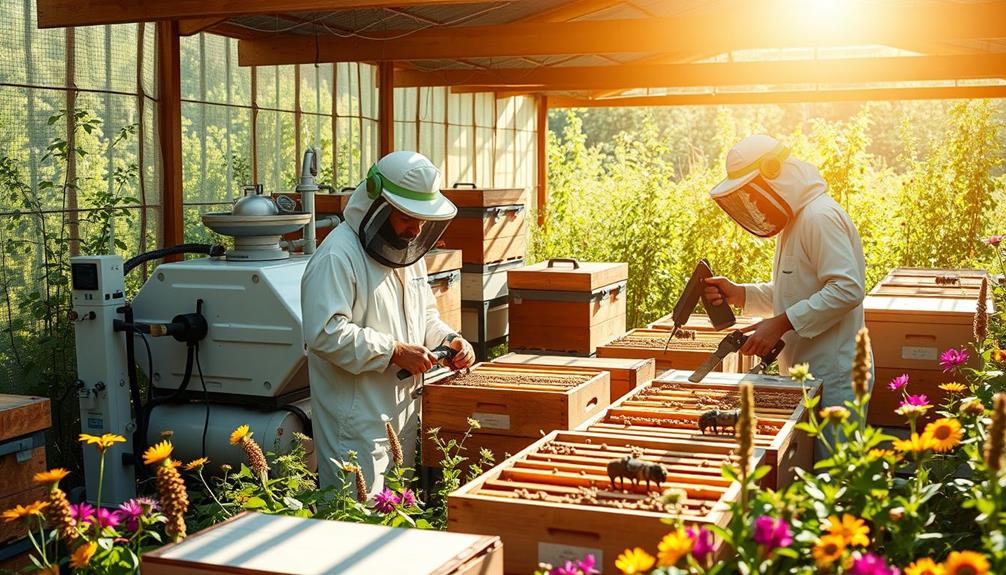To build successful relationships with honey wholesalers, start by understanding their specific needs, like preferences for health-conscious products. Communicate openly about pricing and product specifications, ensuring transparency to foster trust. Regularly share market insights and be responsive to feedback to align your offerings with consumer trends. Maintain consistent contact to update them on honey availability and industry changes. Attend trade shows to network and forge connections. Finally, invest in high-quality labeling and establish a reliable supply chain. By following these strategies, you can create lasting partnerships that benefit both you and your wholesalers. There's much more to explore on this topic.
Key Takeaways
- Establish clear communication about product specifications, pricing, and health benefits to build trust and transparency with wholesalers.
- Provide detailed labeling, including origin and quality information, to enhance product visibility and meet wholesalers' needs.
- Regularly seek feedback from wholesalers and adapt product offerings based on market trends and consumer preferences.
- Maintain a reliable supply chain to ensure timely delivery and consistent product quality, fostering long-term partnerships.
- Attend industry events to network with wholesalers and stay updated on market trends for better alignment with their needs.
Understanding Wholesalers' Needs

To build strong partnerships with honey wholesalers, you need to grasp their specific needs and preferences. First, understand that wholesalers are looking for a variety of honey types, like light flower and dark forest honey. Each variety caters to different consumer tastes, so knowing what they're after is essential.
Additionally, consider that many wholesalers are increasingly aware of health trends, similar to how cold medications can offer various benefits for consumers, making it essential to highlight the health attributes of your honey products.
Labeling also plays a significant role in their decision-making. Wholesalers prioritize products with effective labels that are clear and visually appealing, as these communicate quality and the unique characteristics of the honey.
Moreover, staying informed about health trends can considerably enhance your relationship with wholesalers. They increasingly seek honey products that offer benefits such as immune system support and allergy relief, so showcasing these attributes can give you an edge.
Lastly, reliable and timely delivery is non-negotiable. Wholesalers depend on consistent supply to satisfy their retailer demands and keep their own customers happy.
Effective Communication Strategies

Strong communication is essential for building successful relationships with honey wholesalers. To start, establish clear and open lines of communication to discuss product specifications, pricing, and delivery timelines effectively. This clarity will help you avoid misunderstandings and guarantee that everyone is on the same page.
Additionally, leveraging transparency in private equity can also be beneficial when discussing investment opportunities and expectations.
Utilize digital tools and platforms for regular updates and feedback. By doing this, you'll keep all parties aligned on inventory levels and market trends, enhancing efficiency.
During negotiations, practice active listening. This approach not only helps you understand the wholesalers' needs but also allows you to adjust your strategy accordingly, fostering a collaborative atmosphere.
Maintaining a professional yet approachable demeanor is key. This balance will enhance your relationship's longevity and make it easier to resolve conflicts or address any issues that arise.
Building Trust Through Transparency

Trust is the cornerstone of any successful partnership, especially in the honey industry. To build this trust, transparency is essential. Wholesalers prefer suppliers who can provide detailed information about the origin and quality of their honey.
When you're open about your sourcing practices, you foster confidence and create a positive reputation among distributors. Utilizing essential oils, like eucalyptus oil, can also enhance your product offerings, showcasing a commitment to quality that resonates with health-conscious consumers.
Here are three ways you can enhance trust through transparency:
- Clear Labeling: Confirm your labels include all mandatory information, like expiration dates and honey types. This not only complies with regulations but also shows your commitment to quality.
- Production Insights: Share details about your production practices, especially sustainable beekeeping methods. This illustrates accountability and showcases your dedication to ethical practices.
- Open Communication: Engage with wholesalers through regular updates and discussions about your production process. This transparency strengthens business relationships and shows you're willing to be held accountable.
Sharing Market Insights

To strengthen your connections with honey wholesalers, it's essential to understand market trends and analyze consumer preferences.
Staying updated on what's popular and what health benefits customers seek can give you an edge in your discussions.
Sharing these insights not only fosters collaboration but also positions you as a knowledgeable partner in the industry.
Understanding Market Trends
The honey industry is undergoing significant transformation, driven by evolving consumer preferences and health trends. As a wholesaler, you need to stay ahead of these trends to meet consumer demands effectively.
Increasing interest in unique honey varieties, like Manuka, highlights this shift. You'll want to contemplate how these trends can shape your offerings.
Here are three key market insights to keep in mind:
- Health-Conscious Products: Consumers are gravitating toward hybrid blends that enhance physical health and digestion. Offering products that promote wellness can set you apart.
- Flavor Innovations: The popularity of flavored honey options, such as those infused with ginger, cinnamon, or chocolate, is on the rise. Diversifying your product line can cater to culinary enthusiasts looking for unique flavors.
- Texture Appeal: Whipped honey is gaining traction due to its creamy texture and versatile applications in food. Including this in your inventory could attract new customers.
Analyzing Consumer Preferences
As you navigate the changing landscape of the honey industry, understanding consumer preferences becomes vital for your business's success.
Today's consumers are increasingly drawn to specialty honey varieties, such as Manuka honey, prized for its unique health benefits and distinctive flavor. This trend reflects a broader shift towards natural and health-conscious products.
You'll find that innovative honey blends infused with ingredients like ginger, chocolate, or herbs are gaining traction, highlighting a demand for unique culinary experiences.
Seasonal variations in flower honey also create diverse taste profiles, allowing consumers to explore different flavors throughout the year, which can influence their purchasing patterns.
Moreover, health-conscious buyers are attracted to honey for its immune system support and allergy relief, revealing a significant market for honey products that emphasize these benefits.
To capitalize on this, focus on clear labeling that effectively communicates your product's uniqueness and health advantages. This strategy plays a significant role in capturing consumer attention and driving purchase decisions.
Adapting to Feedback

When you actively embrace constructive criticism from honey wholesalers, you open the door to valuable insights that can enhance your products.
Regular communication channels foster trust, making it easier to implement suggested improvements that meet market demands.
Embrace Constructive Criticism
Constructive criticism acts as an essential tool for honey producers aiming to refine their offerings and stay ahead in a competitive market.
By welcoming feedback from wholesalers, you can identify areas for improvement in your products, whether it's enhancing flavor profiles or redesigning packaging.
Here are three key benefits of embracing constructive criticism:
- Improved Product Quality: Input from wholesalers highlights specific aspects of your honey that may need refinement, leading to better quality products that meet consumer expectations.
- Adaptation to Market Trends: Regularly seeking feedback helps you stay attuned to shifting market demands, ensuring your honey remains competitive and appealing to consumers.
- Fostering Innovation: Utilizing feedback can guide the creation of innovative honey blends that align with current health trends, making your offerings more attractive to health-conscious buyers.
Regular Communication Channels
Establishing regular communication channels with your honey wholesalers is crucial for nurturing strong relationships and fostering trust. When you keep the lines of communication open, you guarantee that both you and your wholesalers stay informed about market trends and product availability.
Utilize feedback mechanisms like surveys or informal check-ins to understand their specific needs and preferences better. Sharing consistent updates on new honey varieties, health benefits, and innovative product trends keeps wholesalers engaged and informed. This not only helps them sell but also drives your sales.
Leveraging digital platforms for communication can streamline your interactions, allowing for quicker response times and efficient sharing of important information regarding pricing and product changes. Encouraging open dialogue about labeling and branding strategies is another important aspect.
When you collaborate on these elements, you enhance product visibility and boost market competitiveness. By prioritizing regular communication and adapting to feedback, you create a partnership that benefits both parties, guaranteeing long-term success in the honey market.
Implementing Suggested Improvements
To thrive in the competitive honey market, you must actively seek and implement feedback from your wholesalers. This approach not only helps you understand their needs and preferences but also guides your improvements in product offerings and branding strategies.
Establishing a system to track and analyze customer feedback is essential, allowing you to make timely adjustments based on market trends.
Here are three key strategies to implement suggested improvements effectively:
- Engage Regularly: Use surveys or informal discussions with honey retailers to gather insights on packaging and labeling preferences that resonate with consumers.
- Utilize Sales Data: Analyze sales trends to identify successful product features. This data can help you adapt future honey varieties or blends to align with customer interests.
- Create Open Communication: Establish a responsive communication channel with honey distributors. This ongoing dialogue about product performance enables you to make swift adaptations based on any suggested improvements.
Establishing Long-term Partnerships

In today's competitive market, forming long-term partnerships with honey wholesalers can greatly enhance your business's success. Start by understanding the specific needs of your wholesalers. Offer a diverse range of honey products, including unique varieties like Manuka honey and innovative blends that cater to varying consumer preferences and health trends.
Effective communication is essential; maintain regular contact and share updates about product availability, labeling changes, and industry trends. This fosters trust and strengthens relationships.
Don't miss out on industry events and trade shows—they're perfect for networking and building face-to-face connections that often lead to more substantial partnerships.
Providing high-quality labeling solutions that align with modern design trends can set your products apart. Wholesalers are always on the lookout for unique offerings to attract consumers, so make sure your labels stand out.
Lastly, establish a reliable supply chain to demonstrate consistency in product quality and timely deliveries. This reliability enhances your reputation with honey wholesalers, making them more likely to prioritize long-term collaboration with you.
Navigating Challenges Together

While challenges in the honey market can seem intimidating, maneuvering through them alongside your wholesalers can turn potential obstacles into opportunities. With around 140,000 beekeepers in Germany, the competitive landscape requires a strategic approach. Collaborating with your wholesalers can help you tackle issues like fluctuating prices and seasonal availability, guaranteeing a more stable supply chain.
To effectively navigate these challenges, consider the following strategies:
- Open Communication: Establish clear channels with your wholesalers to address quality control and labeling compliance. This guarantees your products meet industry standards and build consumer trust.
- Joint Marketing Initiatives: Work together on marketing strategies to enhance brand visibility and share the health benefits of honey. This not only attracts health-conscious consumers but also strengthens your position in the market.
- Participate in Industry Events: Attend industry gatherings with your wholesalers to network and stay updated on market trends. This collaboration can provide insights that help you adapt to changes more efficiently.
Exploring New Opportunities

Building strong relationships with wholesalers opens up a world of possibilities for your honey business. By identifying and researching reputable honey wholesalers, you can discover diverse varieties, from light flower honey to rare types like Manuka honey. This not only expands your product offerings but also attracts a broader customer base.
Attending industry trade shows is another great way to explore new opportunities. These events allow you to network and build relationships with potential partners. Additionally, consider leveraging the growing trend of innovative honey products, such as those blended with spices or herbs. This differentiation can set your offerings apart in a competitive market.
You can also utilize online platforms that connect buyers with honey suppliers, making it easier to access various products and collaboration opportunities. Stay informed about health trends related to honey consumption, like immune system support, to tailor your offerings to meet consumer demands.
Here's a quick overview of potential opportunities:
| Opportunity | Action Required | Potential Benefit |
|---|---|---|
| Diverse Honey Varieties | Research reputable wholesalers | Expand product range |
| Industry Trade Shows | Attend events | Network with potential partners |
| Innovative Honey Products | Develop unique blends | Attract new customers |
| Health Trends | Stay informed and adjust offerings | Meet consumer demands |
Frequently Asked Questions
Why Does Honey Become White and Solid?
Honey becomes white and solid due to crystallization, where glucose sugars precipitate out. Lighter honeys crystallize faster, influenced by temperature and humidity. It's safe to eat, and you can warm it to restore liquid form.
What Is in Honey?
Honey's made up of fructose, glucose, water, and various sugars, along with vitamins and minerals. It's got enzymes that offer antibacterial properties, plus antioxidants that support your immune system and overall health.
Conclusion
To sum up, building strong relationships with honey wholesalers isn't just beneficial; it's essential for long-term success. Did you know that 80% of new business comes from existing customers? By understanding their needs and maintaining open communication, you can foster trust and loyalty. Embrace feedback, share valuable market insights, and explore new opportunities together. This collaborative approach not only helps you navigate challenges but also positions your business for sustainable growth in the honey industry.










